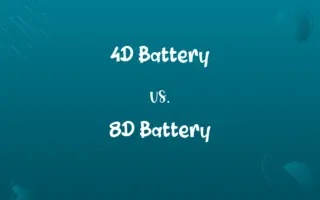Tertile vs. Quartile: Know the Difference

By Shumaila Saeed & Dua Fatima || Published on March 15, 2024
Tertiles divide a data set into three equal parts, highlighting the distribution's middle and extremes, while quartiles split the data into four equal segments, revealing more detailed distribution characteristics, including the median.

Key Differences
Tertiles and quartiles are measures used in statistics to describe the distribution of data by dividing it into equal parts. Quartiles, on the other hand, divide the data set into four equal quarters. The first quartile (Q1) represents the 25th percentile, the second quartile (Q2) is the median or the 50th percentile, and the third quartile (Q3) is the 75th percentile of the data.
Shumaila Saeed
Mar 15, 2024
The choice between tertiles and quartiles depends on the level of detail required in the analysis. Tertiles can be useful for a high-level overview, particularly when a simpler division is sufficient or when the data set is not large enough to necessitate more detailed segments. Quartiles, however, are preferred in more comprehensive analyses, offering a closer look at the data distribution, which is particularly useful for identifying outliers, understanding variability, and comparing different data sets.
Dua Fatima
Mar 15, 2024
In practical applications, quartiles are more commonly used, particularly the median (Q2) as a measure of central tendency and the interquartile range (IQR), which is the difference between Q3 and Q1, as a measure of dispersion. These metrics are fundamental in descriptive statistics, data analysis, and data visualization, aiding in the interpretation and comparison of data sets.
Shumaila Saeed
Mar 15, 2024
Tertiles, splitting the data into three parts, offer a broader overview, identifying the lower third, middle third, and upper third of a data set. This division helps in understanding the distribution's spread and central tendency without providing as much granularity as quartiles. Quartiles not only shows the central tendency but also provides insights into the spread and skewness of the data by detailing how the values are distributed around the median.
Dua Fatima
Mar 15, 2024
Comparison Chart
Number of Parts
Divides data into 3 equal parts
Divides data into 4 equal parts
Shumaila Saeed
Mar 15, 2024
ADVERTISEMENT
Use Case
Suitable for simpler analysis or smaller data sets
Preferred for detailed analysis, identifying outliers, and understanding variability
Shumaila Saeed
Mar 15, 2024
Common Metrics
Middle tertile as a broad measure of central tendency
Median and IQR for central tendency and dispersion
Shumaila Saeed
Mar 15, 2024
Application
High-level distribution analysis
Detailed distribution analysis, outlier detection
Shumaila Saeed
Mar 15, 2024
ADVERTISEMENT
Tertile and Quartile Definitions
Tertile
Used to describe broad sections of a data set.
The lowest tertile in the test scores showed a need for remedial education.
Shumaila Saeed
Mar 01, 2024
Quartile
Offers detailed insights through IQR.
The IQR of the data helped identify outliers in the dataset.
Shumaila Saeed
Mar 01, 2024
Tertile
A division of data into three equal parts.
The income distribution was analyzed by tertiles to identify the middle-income group.
Dua Fatima
Mar 01, 2024
Quartile
Facilitates comparison and variability analysis.
Quartiles were used to compare income levels across regions.
Shumaila Saeed
Mar 01, 2024
Tertile
Simplifies data analysis by focusing on three segments.
Sales data divided into tertiles highlighted seasonal trends.
Hifza Nasir
Mar 01, 2024
ADVERTISEMENT
Quartile
Splits data into four quarters based on distribution.
The lower quartile of the housing prices showed affordable options.
Hifza Nasir
Mar 01, 2024
Tertile
(statistics) Either of the two points that divide an ordered distribution into three parts, each containing a third of the population.
Shumaila Saeed
Mar 01, 2024
Quartile
Includes the median as a central measure.
The median (Q2) represented the midpoint of annual expenditures.
Shumaila Saeed
Mar 01, 2024
Tertile
(statistics) Any one of the three groups so divided.
The first tertile results include January through April's revenues.
Shumaila Saeed
Mar 01, 2024
Quartile
(statistics) Any of the three points that divide an ordered distribution into four parts, each containing a quarter of the population.
Shumaila Saeed
Mar 01, 2024
Quartile
(statistics) any of three points that divide an ordered distribution into four parts each containing one quarter of the scores
Dua Fatima
Mar 01, 2024
Quartile
Any of the groups that result when a frequency distribution is divided into four groups of equal size.
Shumaila Saeed
Mar 01, 2024
Quartile
(statistics) Any one of the four groups so divided.
This school is ranked in the first quartile.
Shumaila Saeed
Mar 01, 2024
Repeatedly Asked Queries
How are quartiles determined in a data set?
Quartiles are determined by sorting the data and then dividing it into four equal parts, using specific positions (25th, 50th, and 75th percentiles) to find Q1, Q2, and Q3.
Shumaila Saeed
Mar 15, 2024
Why use tertiles in data analysis?
Tertiles simplify the understanding of data distribution, making it easier to identify the central portion and extremes without overwhelming detail.
Dua Fatima
Mar 15, 2024
Can tertiles and quartiles be used together?
While not common, both can be referenced in a comprehensive analysis to provide both a broad overview and detailed insights into a data set.
Shumaila Saeed
Mar 15, 2024
Is the median always the second quartile?
Yes, by definition, the median is the second quartile (Q2), dividing the data set into two equal halves at the 50th percentile.
Dua Fatima
Mar 15, 2024
Are tertiles or quartiles better for financial data analysis?
Quartiles are generally preferred for financial data analysis due to their detailed breakdown, which is crucial for understanding distribution, variability, and outlier impacts on financial metrics.
Dua Fatima
Mar 15, 2024
What is the difference between quartiles and percentiles?
Quartiles are a specific type of percentile that divides data into four equal parts. Percentiles divide data into 100 equal parts. Quartiles are the 25th, 50th, and 75th percentiles, representing broader categories of distribution compared to the more granular division of percentiles.
Dua Fatima
Mar 15, 2024
How do tertiles and quartiles affect data visualization?
Tertiles and quartiles are foundational in creating box plots, a type of graph that shows the distribution of data across quartiles (or tertiles), highlighting the median, IQR, and potential outliers. This visual representation aids in understanding the spread and central tendency of the data.
Dua Fatima
Mar 15, 2024
How do quartiles help in outlier detection?
Quartiles, particularly through the IQR, help identify outliers by highlighting data points that lie significantly outside the typical range (below Q1 or above Q3).
Dua Fatima
Mar 15, 2024
How do you calculate tertiles in a dataset?
To calculate tertiles, sort the dataset from smallest to largest. The first tertile (T1) is the value at the 1/3rd of the dataset, the second tertile (T2, also the median of the dataset) at the 2/3rd mark. These points divide the dataset into three equal parts.
Dua Fatima
Mar 15, 2024
Can quartiles be used for all types of data?
Quartiles are most useful for quantitative, continuous data where ranking and distribution are meaningful. They are less applicable to nominal data or datasets with very few unique values, where dividing into quarters may not provide useful insights.
Shumaila Saeed
Mar 15, 2024
What does the interquartile range (IQR) tell you?
The IQR measures the spread of the middle 50% of the data, providing insight into the data's variability and helping identify outliers by focusing on the range within which the bulk of the data lies.
Shumaila Saeed
Mar 15, 2024
Share this page
Link for your blog / website
HTML
Link to share via messenger
About Author
Written by
Shumaila SaeedShumaila Saeed, an expert content creator with 6 years of experience, specializes in distilling complex topics into easily digestible comparisons, shining a light on the nuances that both inform and educate readers with clarity and accuracy.
Co-written by
Dua Fatima






































































